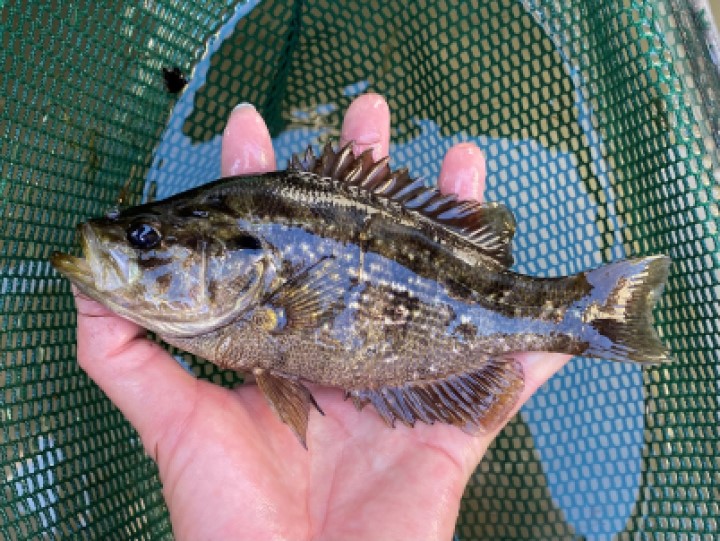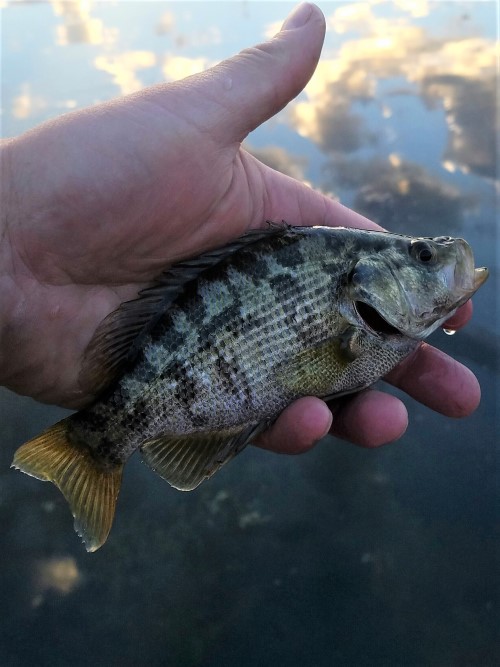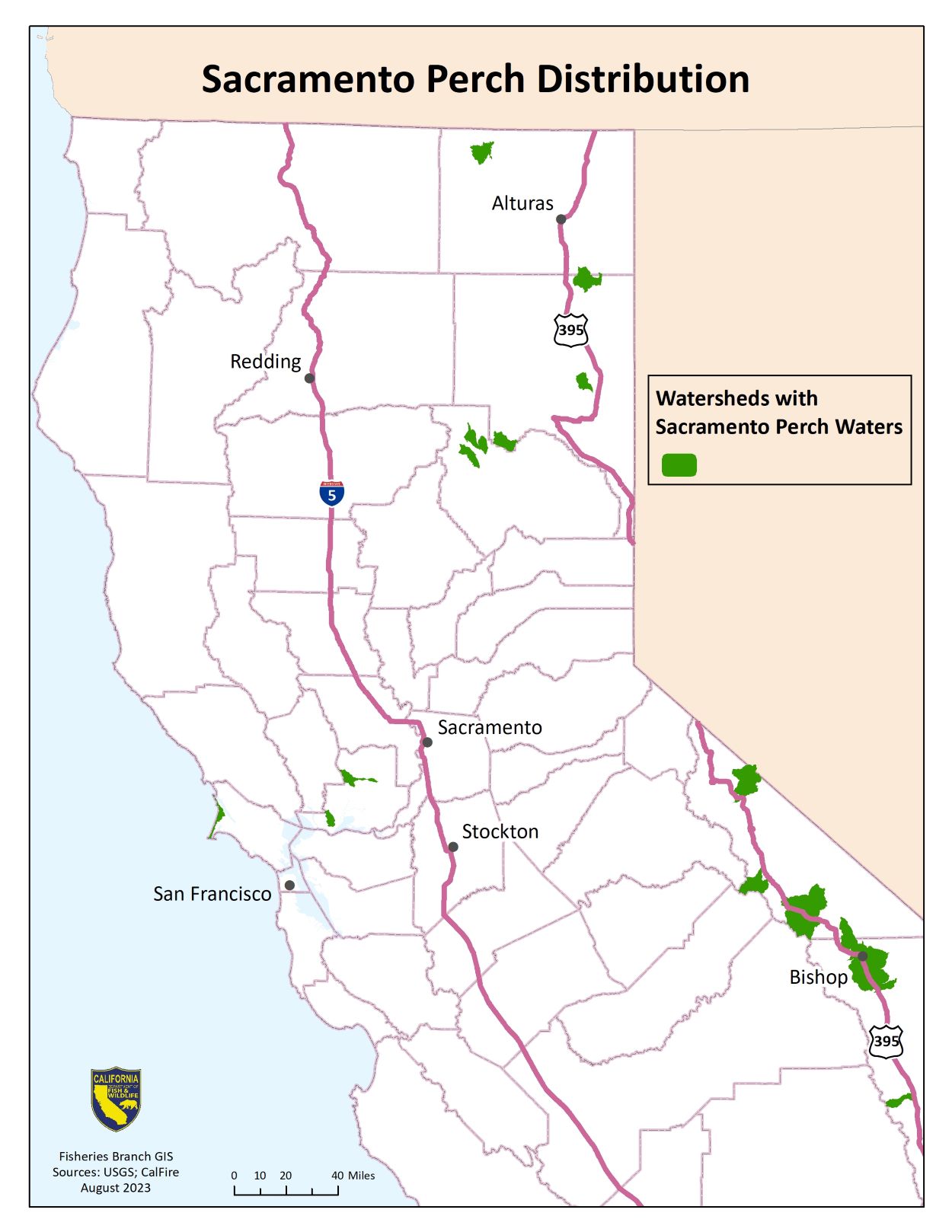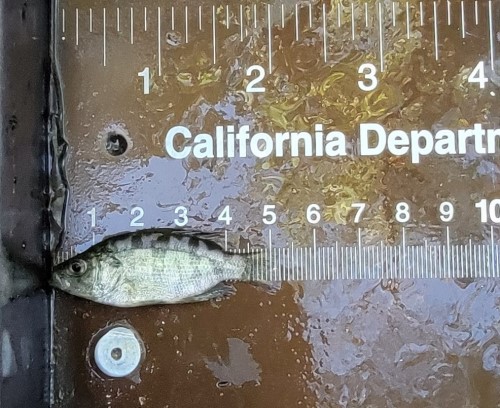Archoplites interruptus
Background
 Sacramento Perch from Lake Almanor. CDFW Photo by Amber Mouser.
Sacramento Perch from Lake Almanor. CDFW Photo by Amber Mouser.
Sacramento Perch is not actually a perch, but is the only member of the Centrarchid family (sunfishes and basses) that is native to California. Because Sacramento Perch historically inhabited the waters of the Central Valley which fluctuated with floods and droughts, it is adapted to withstand wide ranges of water clarity, temperature, dissolved oxygen, salinity and alkalinity.
Though extirpated from its historic range within the Central Valley, it has been transplanted across several western states with mixed success. The extirpation of Sacramento Perch from its historic range was driven by the species’ inability to compete with introduced sunfishes. The biggest impact of introduced sunfishes on Sacramento Perch is direct competition with, and predation on the early life history stages, leading to recruitment failure.
Sacramento Perch is a California Species of Special Concern and now persists only as introduced populations in reproductively isolated waterbodies across California and sporadic locations in other western states. It is a prized gamefish in some waters outside of its historic range where it has become established and still thrives, like Crowley Lake and Bridgeport Reservoir. Current threats to Sacramento Perch include introductions of non-native fishes, drought, and the lack of genetic diversity within remaining populations, which may limit their long-term adaptability to changes in the environment.
 Sacramento Perch from Gray Lodge Wildlife Area. CDFW Photo by Max Fish.
Sacramento Perch from Gray Lodge Wildlife Area. CDFW Photo by Max Fish.
Species Description
Sacramento Perch has a laterally-compressed body shape, similar to other sunfishes. It is generally brown or olive colored and can have a purple or green iridescent sheen. The sides display a broken barring pattern, which gave this fish its Latin name (interruptus) and can distinguish it from other sunfishes. Sacramento Perch can live up to 9 years and can reach sizes in excess of 3lbs. Sacramento Perch build nests and lay eggs like other members of the sunfish family. The number of eggs that a female Sacramento Perch can lay is highly variable and can range from 8,000 to 125,000 eggs at a time (Moyle 2002).
Distribution and Habitat
 Click/tap to enlarge.
Click/tap to enlarge.
Sacramento Perch was historically distributed throughout the Sacramento-San Joaquin Delta, Clear Lake, Pajaro and Salinas River drainages, and tributaries to San Francisco and San Pablo bays. Alteration and reduction of native habitat and competition with introduced fishes contributed to its rapid decline during the end of the 19th century and throughout the 20th century (Moyle 2002). Sacramento Perch populations now exist primarily in lakes and reservoirs to which they were transplanted over the past century. Many of the waters where they persist have water quality conditions that preclude the establishment of competing non-native fishes.
Threats
Currently, one of CDFW's concerns for Sacramento Perch is the lack of genetic diversity within remaining populations, which may limit long-term adaptability to changes in the environment. Because most existing populations are restricted to reservoirs, they are also particularly vulnerable to desiccation during drought conditions and the introduction of non-native fishes.
Conservation and Management
 Juvenile Sacramento Perch. CDFW Photo by Max Fish.
Juvenile Sacramento Perch. CDFW Photo by Max Fish.
To prevent loss of genetic diversity CDFW is translocating Sacramento Perch annually between existing populations. The goals of these translocations are to create gene-flow between isolated populations and reduce the risk of inbreeding depression. In coordination with these translocation activities, CDFW is establishing populations in additional waters which can be easily accessed and managed and where fish can be collected for potential use as broodstock (breeding populations). Having reliable access to genetically diverse broodstock will improve species resiliency by allowing CDFW to expand the current range and create new angler opportunities.
References
- Coen, A.E., Fish, M. Lovell, R. Rodzen, J., Schwartz, R., Schreier, A. 2021. High Levels of Genetic Divergence Detected in Sacramento Perch Suggests Two Divergent Translocation Sources. Transactions of the American Fisheries Society, 150(3), 375–387.
- Moyle, P.B. 2002. Inland Fishes of California, University of California Press.
Native.Fishes@wildlife.ca.gov